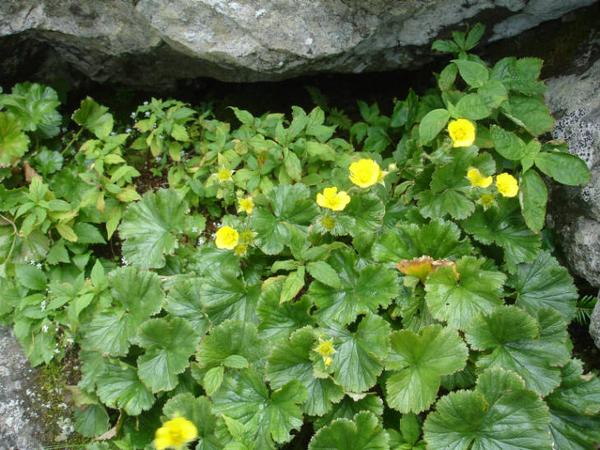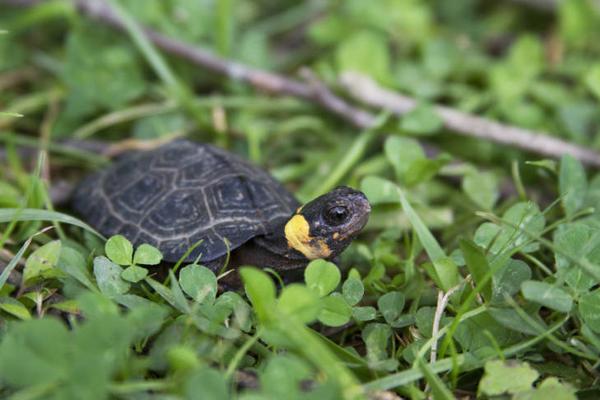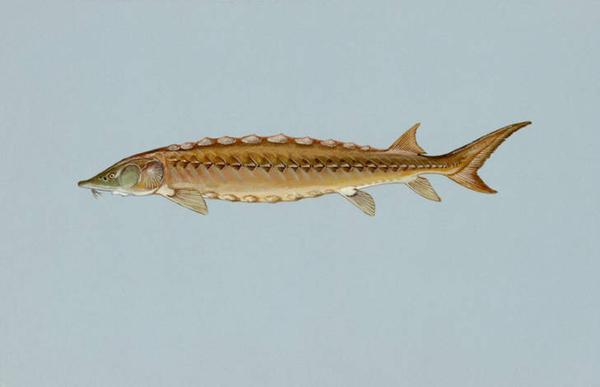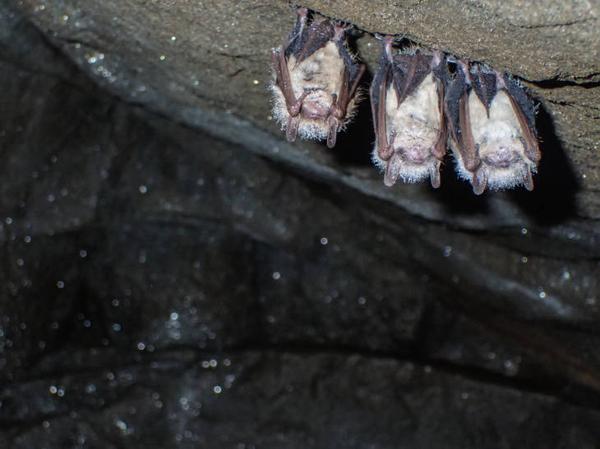Numerous species native to the United States are threatened with extinction, and have been classified as “endangered” or “threatened” by the U.S. Fish and Wildlife Service or the North Carolina Wildlife Resources Commission.
The Endangered Species Act of 1973 defines these classifications as:
Endangered—any species which is in danger of extinction throughout all or a significant portion of its range.
Threatened—any species which is likely to become endangered within the foreseeable future throughout all or a significant portion of its range.
A species can be endangered, threatened, common, or abundant in different parts of its range (example: American alligator). Species identified as endangered or threatened, as well as habitats declared critical to them, are protected under federal and state laws designed to safeguard endangered individuals and promote recovery of the species.
Protective measures for endangered species include:
- preparation of recovery plans
- acquisition and management of essential habitat
- protection from disturbance (pursuing, harming, collecting, harassing, etc.)
Protection from disturbance differs between federally listed endangered and threatened plant and animal species. No penalties are assessed if endangered plant species are harmed in the course of legal land management practices, whereas the taking of an endangered and threatened animal species, or destruction of its critical habitat, either by intent or negligence, is subject to prosecution under Section 9 of the Endangered Species Act. However, destruction of an endangered and threatened plant is subject to prosecution under the Endangered Species Act if the plant is on land under federal jurisdiction (which includes private land under management practices that require federal permits), or if the destruction occurs during the course of another illegal act (such as trespassing).
The N.C. Endangered Species Act (G.S. Chapter 113, Article 25) prohibits the taking of state listed species. The Act also states that it does not limit the rights of a landowner in the lawful management of his/her land. Clearly, the taking of an endangered, threatened, or special concern species through illegal land management activities is a violation of this law.
Forest landowners within the range of the federally listed Red-cockaded woodpecker (RCW) can enroll in the “Red-cockaded Woodpecker Safe Harbor Program” in North Carolina. To be eligible for this program, a property must currently have RCW or have the long-leaf pine habitat to potentially support RCW. By enrolling in this program, landowners agree to implement management techniques that benefit RCW, and in exchange, are granted land management flexibility and a reduction of land use restrictions that would otherwise affect properties with a known population of an endangered species.
North Carolina currently has many plant and animal species listed as threatened or endangered (Table 1), with several other species currently under consideration. Most of these were placed on the endangered species list because of the direct alteration or loss of the species’ habitat. Humans cause a majority of the adverse impacts upon threatened and endangered species, including pollution, urbanization, poorly planned timber harvest, wetland drainage, and conversion of natural areas to agricultural land.
Species listed as federally threatened or endangered are rare throughout their range. Species only on the North Carolina state list may be rare within the state of North Carolina, but more abundant in other parts of their range. Some species may be “under review” or “of concern” meaning they have not formally been listed as federally threatened or endangered, but their status is currently being considered.
Endangered Species Management
Because of the wide variety of threatened and endangered species, management actions for these species are varied and may be highly specific.
Many of the listed fish, mollusks, and amphibians are rare because of water pollution and wetland degradation. Forest land owners can help these species by preserving wetlands, maintaining streamside buffer zones, using fertilizers and pesticides carefully, and keeping silt out of streams during logging and road-building operations.
Many of the listed terrestrial animals are rare because they are closely associated with rare vegetation communities. A few examples are red-cockaded woodpeckers (Iongleaf pine forests), Carolina northern flying squirrels (high elevation spruce-fir and northern hardwood forests), and bog turtles (small bogs in the mountains and Piedmont). Use of management practices that maintain these rare communities or specific elements (e.g., cavity trees) within the communities is the best way to perpetuate these species. Important rare community types include spruce-fir forests, bogs, and balds in the mountains; bottomland hardwood forests and fire-maintained prairies in the Piedmont; and longleaf pine forests, Carolina bays, and maritime forests in the Coastal Plain.
If you believe you might have a threatened or endangered species on your property or in waters associated with your property, consult with a North Carolina Wildlife Resources Commission or U.S. Fish and Wildlife Service biologist about legal management practices and the best ways to enhance habitat for the species.
|
Amphibians |
Federal |
State |
|
Eastern tiger salamander |
X |
|
|
Gopher frog |
X |
|
|
Green salamander |
X |
|
|
Junaluska salamander |
X |
|
|
Mabee's salamander |
X |
|
|
Ornate chorus frog |
X |
|
|
River frog |
X |
|
|
Wehrle's salamander |
X |
|
|
Reptiles |
||
|
American Alligator |
X |
X |
|
Bog turtle |
X |
X |
|
Eastern coral snake |
X |
|
|
Eastern diamondback rattlesnake |
X |
|
|
Green turtle |
X |
X |
|
Hawksbill turtle |
X |
X |
|
Kemp's Ridley turtle |
X |
X |
|
Leatherback turtle |
X |
X |
|
Loggerhead turtle |
X |
X |
|
Northern pine snake |
X |
|
|
Southern hognose snake |
X |
|
|
Birds |
||
|
American peregrine falcon |
X |
|
|
Bachman’s warbler |
X |
|
|
Bald eagle |
X |
|
|
Bewick's wren |
X |
|
|
Caspian tern |
X |
|
|
Common tern |
X |
|
|
Gull-billed tern |
X |
|
|
Henslow's sparrow |
X |
|
|
Kirtland's warbler |
X |
X |
|
Northern saw-whet owl |
X |
|
|
Piping plover |
X |
X |
|
Red cockaded woodpecker |
X |
X |
|
Roseate tern |
X |
X |
|
Rufa red knot |
X |
X |
|
Wayne's black-throated green warbler |
X |
|
|
Wood stork |
X |
X |
|
Crustacea |
||
|
Bennett's Mill cave water slater |
X |
|
|
Insects and Spiders |
||
|
Saint Francis' satyr butterfly |
X |
X |
|
Spruce-fir moss spider |
X |
X |
|
Mussels and Snails |
||
|
Alewife floater |
X |
|
|
Appalachian elktoe |
X |
X |
|
Atlantic pigtoe |
X |
|
|
Barrel floater |
X |
|
|
Big-tooth covert |
X |
|
|
Brook floater |
X |
|
|
Cape Fear threetooth |
X |
|
|
Carolina creekshell |
X |
|
|
Carolina fatmucket |
X |
|
|
Carolina heelslitter |
X |
X |
|
Creeper |
X |
|
|
Dwarf wedgemussel |
X |
X |
|
Eastern lampmussel |
X |
|
|
Eastern pondmussel |
X |
|
|
Engraved covert |
X |
|
|
Fragile glyph |
X |
|
|
Green floater |
X |
|
|
Greenfield rams-horn |
X |
|
|
James spinymussel |
X |
X |
|
Knotty elimia |
X |
|
|
Littlewing pearlymussel |
X |
X |
|
Longsolid |
X |
|
|
Magnificent rams-horn |
X |
|
|
Mountain creekshell |
X |
|
|
Noonday globe |
X |
X |
|
Notched rainbow |
X |
|
|
Purple wartyback |
X |
|
|
Rainbow |
X |
|
|
Roan supercoil |
X |
|
|
Savannah Lilliput |
X |
|
|
Sculpted supercoil |
X |
|
|
Slippershell mussel |
X |
|
|
Smoky Mountain covert |
X |
|
|
Tan riffleshell |
X |
X |
|
Tar River spinymussel |
X |
X |
|
Tennessee clubshell |
X |
|
|
Tennessee pigtoe |
X |
|
|
Tidewater mucket |
X |
|
|
Triangle floater |
X |
|
|
Waccamaw ambersnail |
X |
|
|
Waccamaw fatmucket |
X |
|
|
Waccamaw spike |
X |
|
|
Yellow lampmussel |
X |
|
|
Yellow lance |
X |
X |
|
Fish |
||
|
Atlantic Sturgeon |
X |
X |
|
Bigeye jumprock |
X |
|
|
Blotchside longperch |
X |
|
|
Bridle shiner |
X |
|
|
Cape Fear shiner |
X |
X |
|
Carolina madtom |
X |
|
|
Carolina pygmy sunfish |
X |
|
|
Carolina redhorse |
X |
|
|
Dusky darter |
X |
|
|
Least brook lamprey |
X |
|
|
Logperch |
X |
|
|
Mimic shiner |
X |
|
|
Orangefin madtom |
X |
|
|
Paddlefish |
X |
|
|
Roanoke longperch |
X |
X |
|
Robust redhorse |
X |
|
|
Rosyface chub |
X |
|
|
Rustyside sucker |
X |
|
|
Sharphead darter |
X |
|
|
Sharpnose darter |
X |
|
|
Shortnose sturgeon |
X |
X |
|
Sicklefin redhorse |
X |
|
|
Spotfin Chub |
X |
X |
|
Stonecat |
X |
|
|
Turquoise darter |
X |
|
|
Waccamaw darter |
X |
|
|
Waccamaw silverside |
X |
X |
|
Mammals |
||
|
Carolina northern flying squirrel |
X |
X |
|
Eastern cougar |
X |
X |
|
Eastern woodrat |
X |
|
|
Fin whale |
X |
X |
|
Gray bat |
X |
X |
|
Humpback whale |
X |
X |
|
Indiana bat |
X |
X |
|
Northern long-eared bat |
X |
X |
|
Rafinesque's big-eared bat |
X |
|
|
Red wolf |
X |
X |
|
Right whale |
X |
X |
|
Sei whale |
X |
X |
|
Sperm whale |
X |
X |
|
Virginia big-eared bat |
X |
X |
|
West Indian manatee |
X |
X |
|
Plants |
||
|
American chaffseed |
X |
X |
|
Blue Ridge goldenrod |
X |
X |
|
Bunched arrowhead |
X |
X |
|
Canby's dropwort |
X |
X |
|
Cooley's meadowrue |
X |
X |
|
Dwarf-flowered heartleaf |
X |
X |
|
Golden sedge |
X |
X |
|
Green pitcher plant |
X |
X |
|
Harperella |
X |
X |
|
Heller's blazing star |
X |
X |
|
Michaux's sumac |
X |
X |
|
Mountain golden heather |
X |
X |
|
Mountain sweet pitcher plant |
X |
X |
|
Pondberry |
X |
X |
|
Roan Mountain bluet |
X |
X |
|
Rock gnome lichen |
X |
X |
|
Rough-leaf loosestrife |
X |
X |
|
Schweinitz's sunflower |
X |
X |
|
Seabeach amaranth |
X |
X |
|
Sensitive joint-vetch |
X |
X |
|
Small-anthered Bittercress |
X |
X |
|
Small whorled pogonia |
X |
X |
|
Smooth coneflower |
X |
X |
|
Spreading avens |
X |
X |
|
Swamp pink |
X |
X |
|
Virginia spiraea |
X |
X |
|
White irisette |
X |
X |
The information in the above table is current as of June 2019. For updated current status, please refer to official state and federal status listings.
Working With Wildlife Series
North Carolina State University Extension - Forestry
Working With Wildlife Series
Publication date: June 30, 2019
Reviewed/Revised: May 28, 2024
N.C. Cooperative Extension prohibits discrimination and harassment regardless of age, color, disability, family and marital status, gender identity, national origin, political beliefs, race, religion, sex (including pregnancy), sexual orientation and veteran status.









